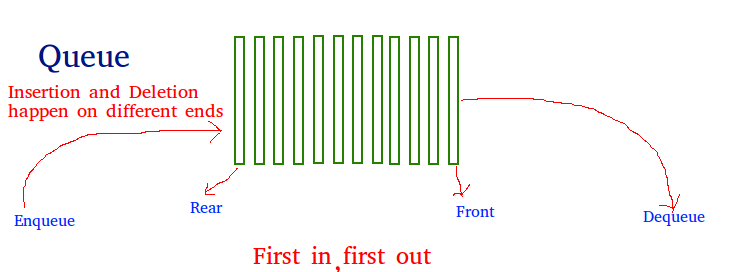数据结构和算法 四、队列
一、队列(Queue)
像堆栈一样,队列是一个线性结构,它遵循执行操作的特定顺序。 顺序是先进先出 (FIFO)。
队列结构其实就是一种线性结构。如果从数据的存储结构来进一步划分,队列结构包括两类。
・顺序队列结构:即使用一组地址连续的内存单元依次保存队列中的数据。在程序中,可以定义一个指定大小的结构数组作为队列。
・链式队列结构:即使用链表形式保存队列中各元素的值。

队列应用广泛,从打印机的作业设置,到网络应用程序的后台任务,都有队列的存在。
二、队列操作
对队列主要进行以下四个基本操作:
Enqueue:将项目添加到队列中。 如果队列已满,则称其为溢出条件。
Dequeue:从队列中删除一个项目。 项目的弹出顺序与它们被推送的顺序相同。 如果队列为空,则称其为下溢条件。
Front:从队列中获取最前面的项目。
Rear:从队列中获取最后一项。

三、实现队列
1、数组实现
(1)出入队列可视化

(2)代码参考
使用java代码进行实现
// Java program for array
// implementation of queue
// A class to represent a queue
class Queue {
int front, rear, size;
int capacity;
int array[];
public Queue(int capacity)
{
this.capacity = capacity;
front = this.size = 0;
rear = capacity - 1;
array = new int[this.capacity];
}
// Queue is full when size becomes
// equal to the capacity
boolean isFull(Queue queue)
{
return (queue.size == queue.capacity);
}
// Queue is empty when size is 0
boolean isEmpty(Queue queue)
{
return (queue.size == 0);
}
// Method to add an item to the queue.
// It changes rear and size
void enqueue(int item)
{
if (isFull(this))
return;
this.rear = (this.rear + 1)
% this.capacity;
this.array[this.rear] = item;
this.size = this.size + 1;
System.out.println(item
+ " enqueued to queue");
}
// Method to remove an item from queue.
// It changes front and size
int dequeue()
{
if (isEmpty(this))
return Integer.MIN_VALUE;
int item = this.array[this.front];
this.front = (this.front + 1)
% this.capacity;
this.size = this.size - 1;
return item;
}
// Method to get front of queue
int front()
{
if (isEmpty(this))
return Integer.MIN_VALUE;
return this.array[this.front];
}
// Method to get rear of queue
int rear()
{
if (isEmpty(this))
return Integer.MIN_VALUE;
return this.array[this.rear];
}
}
// Driver class
public class Test {
public static void main(String[] args)
{
Queue queue = new Queue(1000);
queue.enqueue(10);
queue.enqueue(20);
queue.enqueue(30);
queue.enqueue(40);
System.out.println(queue.dequeue()
+ " dequeued from queue\n");
System.out.println("Front item is "
+ queue.front());
System.out.println("Rear item is "
+ queue.rear());
}
}数组实现的缺点:
1、静态数据结构,固定大小。
2、如果队列有大量的入队和出队操作,在某些时候(在前后索引线性递增的情况下)我们可能无法在队列中插入元素,即使队列是空的(这个问题可以避免通过使用循环队列)。
2、链表实现
(1)出入队列可视化

(2)代码参考
// A linked list (LL) node to store a queue entry
class QNode {
int key;
QNode next;
// constructor to create a new linked list node
public QNode(int key)
{
this.key = key;
this.next = null;
}
}
// A class to represent a queue
// The queue, front stores the front node of LL and rear stores the
// last node of LL
class Queue {
QNode front, rear;
public Queue()
{
this.front = this.rear = null;
}
// Method to add an key to the queue.
void enqueue(int key)
{
// Create a new LL node
QNode temp = new QNode(key);
// If queue is empty, then new node is front and rear both
if (this.rear == null) {
this.front = this.rear = temp;
return;
}
// Add the new node at the end of queue and change rear
this.rear.next = temp;
this.rear = temp;
}
// Method to remove an key from queue.
void dequeue()
{
// If queue is empty, return NULL.
if (this.front == null)
return;
// Store previous front and move front one node ahead
QNode temp = this.front;
this.front = this.front.next;
// If front becomes NULL, then change rear also as NULL
if (this.front == null)
this.rear = null;
}
}
// Driver class
public class Test {
public static void main(String[] args)
{
Queue q = new Queue();
q.enqueue(10);
q.enqueue(20);
q.dequeue();
q.dequeue();
q.enqueue(30);
q.enqueue(40);
q.enqueue(50);
q.dequeue();
System.out.println("Queue Front : " + q.front.key);
System.out.println("Queue Rear : " + q.rear.key);
}
}四、其它队列类型
1、循环队列
在循环队列中,所有节点都表示为循环。它类似于线性队列,只是队列的最后一个元素连接到第一个元素。它也称为环形缓冲区,因为所有端都连接到另一端。循环队列的表示如下图所示 -

使用循环队列克服了线性队列中出现的缺点。如果循环队列中有可用的空白空间,则可以通过简单地增加rear的值将新元素添加到空白空间中。使用循环队列的主要优点是更好的内存利用率。
2、双端队列
双端队列是一种线性数据结构,插入和删除操作都是从两端进行的。
虽然在一个双端队列中的插入和删除都可以在两端进行,但它并不遵循先进先出规则。

有两种类型的双端队列
输入受限队列
在输入受限队列中,只能在一端进行插入操作,而从两端都可以进行删除操作。

输出受限队列
在输出受限队列中,删除操作只能在一端进行,而插入则可以从两端进行。

3、优先队列
优先队列是一种特殊类型的队列,其中元素根据优先级排列。它是一种特殊类型的队列数据结构,其中每个元素都有一个与之关联的优先级。假设某些元素以相同的优先级出现,它们将按照先进先出原则进行排列。优先队列的表示如下图所示 -

优先队列中的插入基于到达发生,而优先队列中的删除基于优先级发生。优先级队列主要用于实现 CPU 调度算法。
升序优先级队列 -在升序优先级队列中,可以按任意顺序插入元素,但只能先删除最小的元素。假设一个数组的元素 7、5、3 的顺序相同,那么,插入可以按照相同的顺序进行,但删除元素的顺序是 3、5、7。
降序优先级队列 -在降序优先级队列中,可以按任意顺序插入元素,但只能先删除最大的元素。假设一个数组中元素 7、3、5 的顺序相同,那么,插入可以按照相同的顺序进行,但删除元素的顺序是 7、5、3。
相关文章
- 【C/C++学院】0828-STL入门与简介/STL容器概念/容器迭代器仿函数算法STL概念例子/栈队列双端队列优先队列/数据结构堆的概念/红黑树容器
- 数据结构与算法JavaScript (二) 队列
- Java实现 LeetCode 587 安装栅栏(图算法转换成数学问题)
- Java实现 蓝桥杯 算法提高最小方差生成树
- Java实现 蓝桥杯 算法训练 Multithreading
- Java实现 蓝桥杯 算法提高 队列操作
- Java实现 蓝桥杯 算法提高 队列操作
- Java实现 蓝桥杯 算法训练 出现次数最多的整数
- 从零开始入门 K8s | 调度器的调度流程和算法介绍
- 【学习总结】java数据结构和算法-第三章-稀疏数组和队列
- 数据结构与算法02 之栈与队列
- 【python cookbook】【数据结构与算法】5.实现优先级队列
- 算法设计 - 01背包问题的状态转移方程优化,以及完全背包问题
- 5.4 heapq--堆队列算法
- 数据结构与算法之队列

